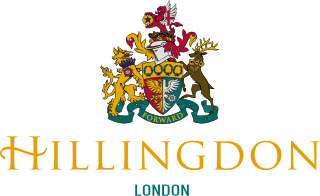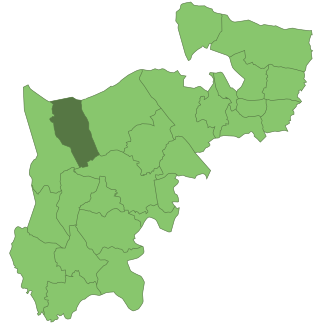
Ickenham is an area in Greater London, forming the northern part of Uxbridge and within the London Borough of Hillingdon.

Northwood is an area in the London Borough of Hillingdon, North West London, located 14+1⁄2 miles northwest of Charing Cross. Northwood was part of the ancient parish of Ruislip, Middlesex. The area was situated on the historic Middlesex boundary with Hertfordshire, and since being incorporated into Greater London in 1965, has been on the Greater London boundary with that county.

Ruislip is a suburb in the London Borough of Hillingdon in West London. Prior to 1965 it was in Middlesex. Ruislip lies 13.8 miles (22.2 km) west-north-west of Charing Cross, London.

The London Borough of Hillingdon is a London borough in Greater London, England. It forms part of outer London and West London, being the westernmost London borough. It was formed in 1965 from the districts of Hayes and Harlington, Ruislip-Northwood, Uxbridge, and Yiewsley and West Drayton. The borough includes most of Heathrow Airport and Brunel University, and is the second largest of the 32 London boroughs by area.

South Ruislip is an area of west London in the London Borough of Hillingdon.

Eastcote is a suburban area in the London Borough of Hillingdon, in west London.

Ruislip-Northwood was an urban district in west Middlesex, England, from 1904 to 1965. From its inception Ruislip-Northwood fell within the Metropolitan Police District and from 1933 it was part of the London Passenger Transport Area.

Ruislip Manor is an area of Ruislip in the London Borough of Hillingdon in West London. It is located approximately 13 miles (20.9 km) west north west of Charing Cross.

Ruislip Lido is a reservoir and artificial beach in Ruislip, within the London Borough of Hillingdon, England, situated between Ruislip Common, Ruislip Woods, and Poor's Field.

Mount Vernon Hospital is a hospital located in Northwood in the London Borough of Hillingdon. It is one of two hospitals run by The Hillingdon Hospitals NHS Foundation Trust, the other being Hillingdon Hospital.

Alice Spencer, Countess of Derby was an English noblewoman from the Spencer family and noted patron of the arts. Poet Edmund Spenser represented her as "Amaryllis" in his eclogue Colin Clouts Come Home Againe (1595) and dedicated his poem The Teares of the Muses (1591) to her.

Ruislip Woods is a Site of Special Scientific Interest and national nature reserve covering 726 acres (294 ha) in Ruislip in the London Borough of Hillingdon. The woods became London's first national nature reserve in May 1997. Ruislip Local Nature Reserve at TQ 090 899 is part of the national nature reserve.

RAF Eastcote, also known over time as RAF Lime Grove, HMS Pembroke V and Outstation Eastcote, was a UK Ministry of Defence site in Eastcote, Middlesex.

Manor Farm is a 22-acre (8.9 ha) historic site in Ruislip, Greater London. It incorporates a medieval farm complex, with a main old barn dating from the 13th century and a farm house from the 16th. Nearby are the remains of a motte-and-bailey castle believed to date from shortly after the Norman conquest of England. Original groundwork on the site has been dated to the 9th century.

Highgrove House, also known as High Grove House or High Grove, is a Grade II listed mansion in the suburban area of Eastcote, within the London Borough of Hillingdon. Originally built in 1750 by the Reverend John Lidgould, the house was rebuilt in 1881 by Sir Hugh Hume-Campbell following a catastrophic fire. Along with Haydon Hall and Eastcote House, Highgrove was one of the three main houses of Eastcote and eventually became a residential hostel for homeless families, run by the local council from the 1960s until 2007. An area of the estate was sold to the local council in 1935 by the then-owner Eleanor Warrender to become what is now Warrender Park. In 1975, the house was granted Grade II listed status on account of its special architectural character.

St. Giles' Church is the parish church in Ickenham, within the London Borough of Hillingdon in England.

St Martin's Church is a church in the west London town of Ruislip, within the London Borough of Hillingdon. It has been designated since January 1950 by English Heritage as a Grade I listed building. The present chancel and nave date back to the 13th century. The church stands at the northern end of Ruislip High Street, near the Manor Farm site.

Eastcote House Gardens is an area of public parkland in Eastcote, within the London Borough of Hillingdon. The site covers 3.63 hectares and incorporates the walled garden, dovecote and coach house of Eastcote House. The house was demolished in 1964 by the then Ruislip-Northwood Urban District Council (RNUDC), one of the predecessors of the London Borough of Hillingdon which was formed the following year. At the public's request, the garden and outbuildings were retained and are now maintained by a group of volunteers, the Friends of Eastcote House Gardens, in partnership with the local authority.





















